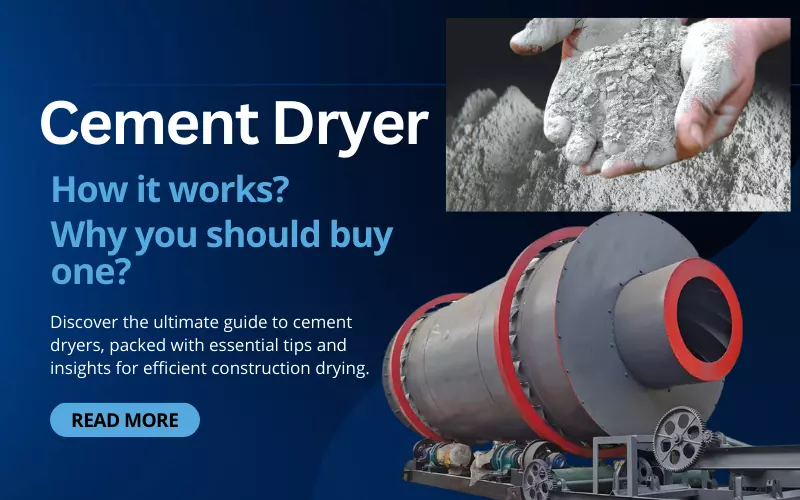
The Ultimate Guide to a Cement Dryer: How They Work and Why You Need One
Have you ever considered using a cement dryer? The cement production process is quite intricate and fascinating, and one of the steps is cement drying. In this post, we will delve into the realm of a cement dryer and examine its significance in the cement manufacturing sector.
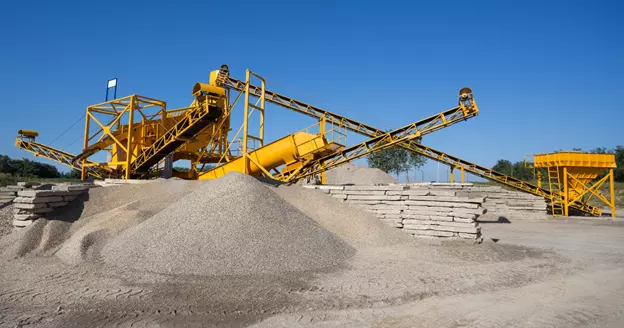
An essential building component utilized in construction projects all around the world is cement. In order to create clinker, a mixture of raw materials, including limestone, clay, and shale, are fired in a kiln. Following the cement production process, the clinker must be dried before being ground into a fine powder and used to manufacture cement. That’s when a cement dryer is crucial.
Specialized machinery known as a cement dryer is used to dry cement clinker, improving its quality and maintaining its stability. They enable the creation of high-quality cement that satisfies industry requirements, making them a crucial part of the cement manufacturing process.
In this article, we will look at the types of cement dryers, how they operate, and what advantages they provide for cement businesses.
Definition and Purpose of Cement Dryer
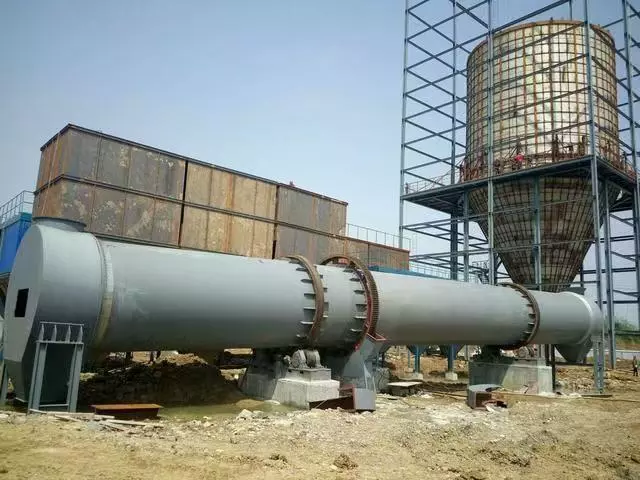
The cement industry uses cement dryers, often referred to as rotary dryers, as specialized machinery to quickly and effectively dry raw materials. These dryers’ primary function is to lower the moisture content of wet materials before further processing, such as raw cement and coal powder.
Cement industry dryer use heated and exhaust gases from the cement factory to create a parallel air stream that moves through the drying process, effectively removing moisture. These dryers guarantee that the residence duration is meticulously controlled, resulting in thoroughly dried materials thanks to their cutting-edge technology and effective heat transmission systems.
Importance of Cement Dryers in the Cement Production Process
In the cement production process, cement dryers are essential. Before being fed into the rotary kiln to produce clinker, these dryers are used to dry the wet materials. The drying process is essential for assuring the quality and stability of the finished cement product since it aids in removing the excess moisture and water content from the ingredients.
In the cement business, using cement dryers has a number of benefits. The process’s thermal efficiency is improved, which lowers energy use and operational expenses. Additionally, it enables the drying of a variety of materials, such as coal powder and different raw materials used in the manufacture of cement.
Cement dryers’ usefulness in a cement plant is further increased by ease of use and practical maintenance.
Furthermore, because they frequently include cyclone dust collectors to trap and remove dust particles, cement dryers help to lower the amount of dust in the environment. In closed-circuit grinding facilities, where dust control is required, this is especially important.
How Cement Dryers Work
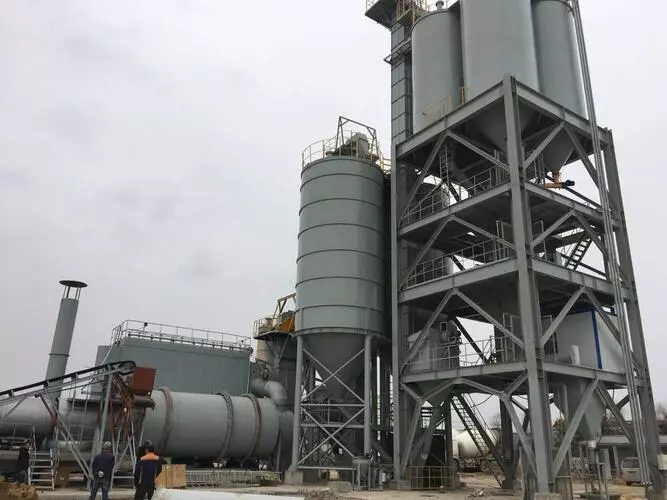
The use of heat to evaporate moisture from cement ingredients is the basis for the operation of cement dryers. To accomplish efficient and effective drying, the cement drying process includes a number of crucial elements and procedures.
Drying Mechanism Explained
Cement dryers’ drying mechanisms are an essential step in the cement production process of effectively removing moisture from wet materials like the raw materials used in the cement production process. Heat is transferred when wet items move together in the dryer drum and come into contact with the hot air stream.
The materials are exposed to the hot air stream’s greatest temperature as they reach the dryer’s input, which speeds up the evaporation of moisture. The effectiveness of drying is maximized by the parallel flow principle, which makes sure that the materials and hot air stream move in the same direction.
The design of the revolving drum is essential to the cement production process. It continuously stirs and rotates the materials, ensuring that each piece is exposed to the hot air stream in the same way and facilitating quick drying. By regulating the rotation speed and drum slope, the residence duration of the materials in the dryer may be precisely regulated to achieve the necessary moisture content.
There are many different types of cement dryers on the market, each created to meet certain drying needs in the cement industry.
The cement rotary dryer is one type that is frequently used; it speeds up the cement production process by using a rotating drum. Cement rotary dryers are renowned for their many uses, ease of use, and practical maintenance.
The belt conveyor dryer is an additional kind of cement drier that dries wet materials continuously with warm air. Large-scale cement mills frequently employ this kind of drier since it has a high drying efficiency.
Additionally, to ensure effective drying and lower energy consumption, certain cement dryers use cutting-edge technologies including pneumatic tools and draft fans. High-capacity cement companies that need a quicker cement production process frequently utilize these dryers.
Advantages of Using Cement Dryers
Using efficient cement dryer in the cement industry has a number of benefits. The two main benefits are as follows:
1. Faster and More Efficient Drying
One significant benefit of cement dryers is faster and more effective drying. The cement drying process takes much less time with these dryers because they are made to give quick and complete drying.
Cement dryers can successfully remove moisture from wet materials in a shorter amount of time because of their cutting-edge technology and effective heat transfer mechanisms, boosting the overall output capacity of cement plants.
2. Consistent Quality and Reduced Contamination Risks
Consistently high-quality drying results are one of the main advantages of employing cement dryers. These dryers guarantee even drying of the materials, producing materials with a constant moisture content.
In the cement industry, consistency is essential since it has a direct impact on the end product’s quality and functionality. Cement dryers assist in ensuring that the manufactured cement consistently fulfills the required criteria by removing uneven drying and minimizing changes in moisture content.
Key Components of a Cement Dryer
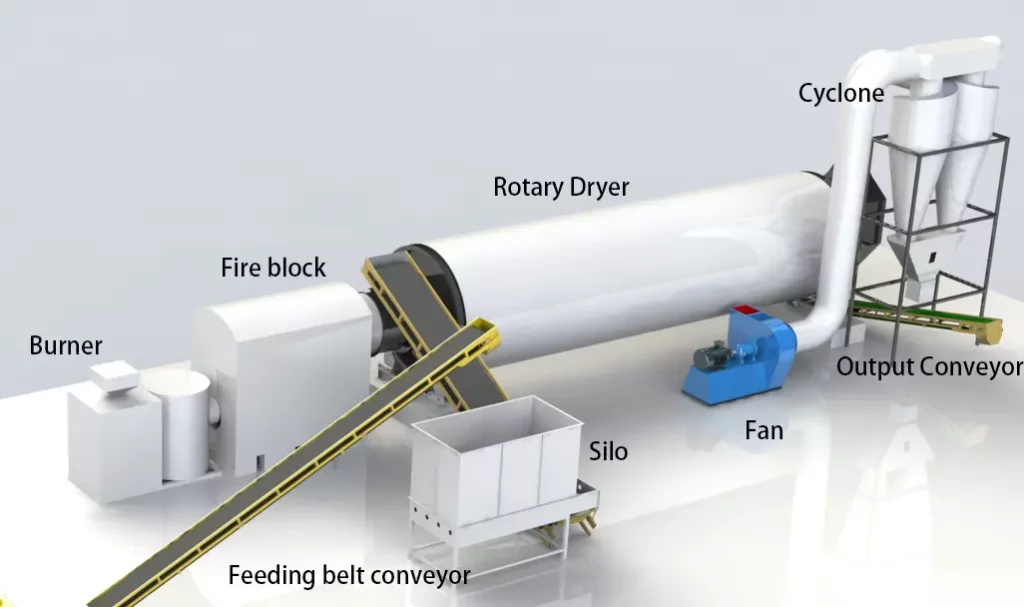
A cement production dryer is made up of a number of essential parts that cooperate to enable quick and thorough drying of wet materials. The three main parts of a cement dryer are listed below:
1. Drying Chamber
A significant part of a cement dryer that is essential to the cement production process is the drying chamber. The space needed for the wet materials to dry properly is provided by this chamber, which also ensures even heating throughout.
To achieve the necessary moisture content in the cement raw materials, the drying chamber’s design and construction are optimized. Modern technology and features, including a parallel flow system, are frequently included to improve drying effectiveness and reduce energy use.
Additionally, the drying chamber helps to remove moisture using exhaust gases and keeps the atmosphere under negative pressure. It is made to handle a variety of additives and raw materials used in the cement industry as well as other bulk materials.
The drying chamber’s valves and control systems allow for simple maintenance and the quick adjustment of residence time and ambient temperatures in accordance with particular drying needs.
2. Heating Systems: Direct vs. Indirect Heat
Direct heat and indirect heat are the two primary choices when it comes to heating systems.
While indirect heat systems rely on the employment of a heat exchanger to transmit heat indirectly, direct heat systems involve the direct transfer of heat energy to the item being heated. Both approaches are advantageous and appropriate for various purposes.
Due to their simplicity and effectiveness, direct heat systems are frequently preferred. They allow for a faster heat transfer since they include direct contact between the heat source and the substance being heated.
Because of this, direct heat systems are perfect for processes where time is of the essence, like drying in the cement industry. Direct heat systems are a cost-effective choice since they frequently use less energy and require less maintenance.
3. Air Circulation and Control Mechanisms
Air circulation and control mechanisms in cement dryers are essential for guaranteeing quick and thorough cement drying processes. To effectively transfer heat to wet surfaces and speed up the evaporation of moisture, hot gases must be circulated.
This is accomplished by carefully planned air streams inside the dryer’s cylinder or drum.
Cement dryers include a variety of techniques to regulate the cement production process. Utilizing draft fans, which support maintaining negative pressure inside the dryer, is one frequent technique.
The elimination of damp exhaust gases and the smooth flow of hot gases are both guaranteed by this negative pressure. Furthermore, modern control systems with built-in sensors and valves let operators adjust variables like temperature, humidity, and residence duration to create the ideal drying environment.
For the necessary moisture content to be reached and problems like overdrying or incomplete drying to be avoided, effective air circulation and control mechanisms are essential. These techniques also aid in reducing energy usage and improving the cement dryers’ ability to produce.
Types of Cement Dryers
Cement dryers come in a variety of designs that are all intended to meet the various needs and specifications of the cement industry.
● Rotary Cement Dryer
Due to its effective drying characteristics, the rotary cement dryer is a preferred option in the cement industry. This kind of dryer has a spinning drum that makes it easier to dry wet raw materials for cement and coal powder. It is renowned in the cement industry for its broad variety of uses and good thermal efficiency.
The rotary cement dryer is frequently used in cement plants to dry bulk materials with a high moisture content due to its straightforward operation and convenient maintenance. The cement rotary dryers’ durable construction and cutting-edge technology guarantee effective drying, lowering the materials’ moisture content and increasing the cement factory’s overall output capacity.
The rotary drum forms a closed circuit system for drying that efficiently reduces energy consumption and dust content in the exhaust gases combined with the combustion chamber, draft fans, and cyclone dust collector.
● Fluidized Bed Dryers for Cement
For effective drying of cement raw materials, a fluidized bed dryer is a type of dryer that is frequently used in the cement industry. The fluidization principle underlies how this dryer works. When hot air or gas is passed through a porous bed of wet materials, the materials begin to behave like fluids.
The fluidized bed dryer has a number of benefits, such as excellent thermal efficiency, a variety of applications for drying different kinds of wet materials, ease of use, and straightforward maintenance. Additionally, it enables the efficient removal of dust by using a cyclone dust collector.
● Vertical Cement Dryer
An expert piece of machinery used in the cement industry to dry various raw materials is called a vertical cement dryer. It is intended to effectively and efficiently remove moisture from wet materials, preserving the finished product’s quality and viability.
The ability to fit into small places within a cement factory is one of the main benefits of a vertical cement dryer. By enabling hot gases to move parallel to the wet materials, the vertical orientation also facilitates effective drying by optimizing heat transmission.
Modern technology and features, including a rotary drum, cyclone dust collector, and draft fans, are included in vertical cement dryers. The materials are dried thoroughly and uniformly thanks to the rotating drum, and a dust-free workspace is provided by the cyclone dust collector.
The effective passage of hot gases and moisture removal is made possible by the draft fans’ creation of negative pressure.
Selecting the Right Cement Dryer
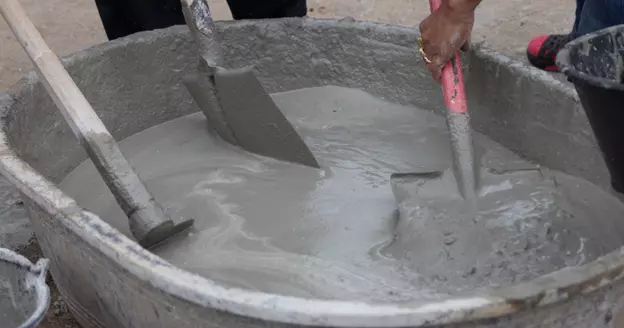
For the cement industry to effectively and efficiently dry wet materials, choosing the correct cement drier is essential. There are many things to take into consideration while purchasing a cement drier.
1. Capacity and throughput factors to take into account
Capacity and throughput are important considerations when it comes to cement dryers. The largest number of materials that can be processed in a specific amount of time is referred to as a cement dryer’s production capacity.
It is crucial to pick a dryer that complies with the unique manufacturing needs of the cement business.
On the other side, throughput describes the speed at which the materials go through the drier. Maintaining the quality and consistency of raw materials for cement requires effective drying. As a result, it’s crucial to pick a dryer that can manage the necessary throughput rate without sacrificing drying effectiveness.
The capacity and throughput of a cement dryer are greatly impacted by variables including dryer type, residence time, and heat transfer. Different dryer types, like cement rotary dryers and drum dryers, provide a variety of solutions to meet various manufacturing needs.
The amount of time the materials spend inside the dryer affects both the cement drying process and the finished product’s moisture content.
2. Energy Efficiency and Sustainability Factors
When selecting a cement dryer, energy efficiency, and sustainability are crucial things to take into account. Because of the high energy consumption of the cement industry, adopting energy-efficient drying techniques can greatly save operating costs and have a positive influence on the environment.
The dryer’s thermal efficiency is one important thing to take into account. Thermal efficiency improvements may lead to lower energy use and greenhouse gas emissions. Technologies that can maximize heat transfer and raise overall energy efficiency include parallel flow and the use of exhaust gases.
The decrease in trash and dust emissions should be taken into account as another aspect of sustainability. Cyclone dust collectors and closed-circuit grinding facilities can be used to reduce the amount of dust produced during the cement production process.
These methods promote raw material utilization, waste reduction, and cement production process efficiency in addition to air quality improvement.
Optimizing Cement Drying Efficiency
Certain tactics can be used to improve cement drying’s effectiveness.
Preparations & Techniques for Pre-Drying
Pre-drying is a critical step in the manufacturing process in the cement industry. Before the raw materials are put into the rotary kiln for additional processing, the moisture from the materials must be removed. This is crucial to ensuring the cement mill runs well and without a hitch.
Several elements need to be taken into account in order to achieve good pre-drying.
First and foremost, the type of dryer is crucial; depending on the requirements of the cement mill, it may be a cement rotary dryer or a belt dryer. To reach the necessary moisture content in the raw materials, the residence duration and temperature of the cement drying process must be regulated.
Additionally, the effectiveness of drying can be significantly improved by using cutting-edge technologies like pneumatic equipment and effective heat transmission systems. To guarantee the longevity and effectiveness of the pre-drying equipment, proper maintenance practices are also essential.
This includes routinely cleaning the dryer drum or belt conveyor to get rid of any dust or other pollutants that have accumulated over time. In order to prevent equipment damage and to guarantee that the cement production process capacity is maximized, it is also crucial to monitor and regulate the moisture content of the raw materials.
Strategies for Reducing Energy Consumption
In the cement business, lowering energy use is a primary aim, and cement dryers are included in this effort. Cement factories can decrease their energy use and lower their overall operating costs by putting into practice smart solutions. Enhancing the drying process’s thermal effectiveness is one tactic.
This can be accomplished by minimizing heat loss and maximizing heat transfer by employing high-quality insulation materials for the dryer’s cylinder and drum. A different strategy is to use as little energy as possible to remediate exhaust gases.
The requirement for additional energy consumption can be decreased by using closed-circuit grinding facilities and cyclone dust collectors to help capture and recycle hot gases.
Safety Measures and Maintenance
When using a cement dryer, security must always come first. To guarantee safe and effective operation, adhere to these safety precautions and maintenance guidelines.
Safety Protocols in Cement Drying Facilities
In cement drying plants, safety procedures are essential for maintaining the health and safety of employees and preventing accidents. These protocols provide instructions on how to handle raw materials correctly and safely operate the cement drying machine.
Workers should receive thorough instruction on how to operate and maintain cement dryers, with a focus on safety precautions. This entails being aware of the dangers of handling wet materials as well as the potential problems posed by high temperatures and dust concentration.
To reduce exposure to any toxic substances, personal protection equipment (PPE), such as protective clothing, gloves, and masks, should be made available to all personnel. PPE usage should be governed by specific rules that must be rigorously followed.
All machinery and equipment should undergo routine inspections to find any potential risks or flaws that could jeopardize safety. To evacuate hot gases and reduce the risk of fire or explosion, proper ventilation and exhaust systems should be in place.
Regular Maintenance and Inspection
For cement dryers to operate safely and effectively, routine maintenance and inspection are essential. Regular inspections allow for the early detection and correction of any risks or deficiencies, reducing the possibility of accidents.
To guarantee optimum performance and increase the equipment’s lifespan, maintenance procedures like lubricating moving parts, cleaning dust filters, and inspecting the dryer drum and cylinder should be carried out on a regular basis.
To guarantee proper ventilation and the evacuation of hot gases, this includes examining the exhaust systems and draft fans. The risk of fire or explosion can be reduced and the overall safety of the plant can be improved by following a thorough maintenance schedule.
Cement Dryer vs. Traditional Drying Methods
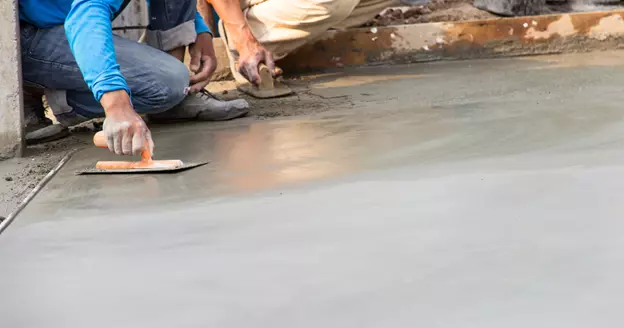
The advantages and drawbacks of cement dryers can be better understood by contrasting them with conventional drying techniques.
Advantages and Disadvantages
The cement industry and other associated industries find cement dryers to be the perfect solution because they provide numerous benefits in the cement drying process. Improved drying efficiency is achieved by the rotational drum design, which guarantees effective drying of wet materials with high moisture content.
Cement dryers contribute to low maintenance costs through easy operation and convenient maintenance. Utilizing cutting-edge technology, such as cyclone dust collectors, aids in maintaining a dust-free and effective drying process.
Cement dryers are also adaptable and have a variety of uses outside the cement industry, including the chemical and building materials sectors. However, there are a few drawbacks to cement dryers as well.
The amount of energy needed to run these dryers is one of the key issues. Although their thermal efficiency is often excellent, specific actions must be made to cut energy use and improve the cement drying process.
The potential for higher moisture content in the finished product as a result of elements like ambient temperatures and the particular dryer type employed is another disadvantage. It could be necessary to further regulate this moisture content in subsequent steps.
Despite these drawbacks, cement dryers are a necessary piece of equipment in the cement industry and other related industries due to their many benefits and adaptability.
Comparison with Drum Dryers and Sun Drying
Cement dryers have been shown to be more effective than both drum dryers and sun drying techniques when it comes to drying wet materials. Cement dryers use a rotary drum design, which enables efficient drying and enhanced drying efficiency, in contrast to drum dryers, which may not deliver efficient drying due to their revolving drum design.
Contrarily, sun drying is very dependent on the surrounding environment and is unpredictable, which results in drying delays. With their cutting-edge technology and control systems, cement dryers offer a dependable and uniform cement drying process regardless of the surrounding temperature.
Cement dryers can also be used to dry a variety of items, including raw materials and bulk materials, and are not just confined to certain kinds of materials. Cement dryers save money and time over both drum dryers and sun drying techniques thanks to their easy maintenance and straightforward operation.
Ultimately, cement dryers perform better in terms of drying effectiveness, adaptability, and operational dependability than drum dryers and sun drying.
Regulatory Compliance and Safety Standards
Compliance with regulations and safety requirements. Safety and regulatory compliance are of the utmost significance in the cement sector. To avoid mishaps and maintain the safety of their employees, cement manufacturers must follow tight regulations.
Industry Regulations for Cement Drying
Standards and laws that govern the cement industry guarantee secure and effective cement drying procedures. These rules cover a range of topics, such as quality control, safety precautions, and environmental impact. The thermal effectiveness of cement dryers is a major subject of interest.
Cement plants are required to employ cement rotary dryers with excellent thermal efficiency to meet requirements, enabling efficient drying while consuming the least amount of energy.
Additionally, rules demand that cement manufacturing facilities have efficient dust-collecting equipment, including cyclone dust collectors, to regulate and reduce dust emissions throughout the cement drying process.
The upkeep of cement dryers is another essential component. Regulations place a strong emphasis on the necessity of routine maintenance to guarantee a secure and efficient operation, as well as to lower maintenance costs and downtime.
Occupational Health and Safety Guidelines
Guidelines for occupational health and safety are essential for assuring the protection and well-being of workers across a variety of industries. These recommendations offer a framework for businesses to establish a secure and healthy workplace, lowering the possibility of mishaps, injuries, and long-term health problems.
They include a wide range of topics, such as the safe handling of hazardous products, how to utilize equipment properly, how to implement emergency procedures, and how to provide the right training and safety equipment.
Employers can reduce the possibility of accidents and foster a culture of safety within the workforce by following these recommendations.
Troubleshooting Common Cement Dryer Issues
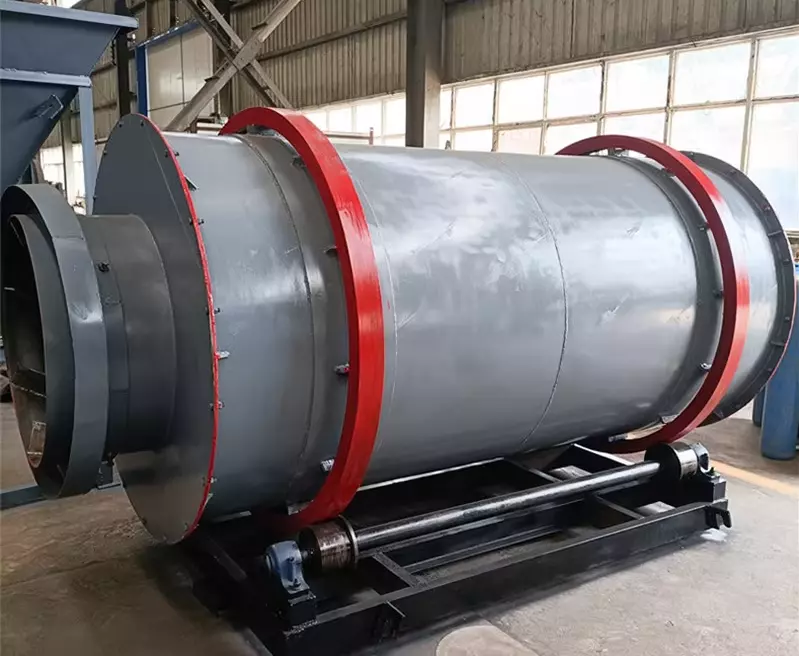
Common problems can occur while drying cement operations. Here are some efficient troubleshooting techniques to handle them.
Addressing Uneven Drying and Moisture Content Variations
To maintain high-quality cement manufacturing, it is essential in the cement industry to achieve a uniform and consistent moisture content during the cement drying process. The strength and durability of the finished product might be adversely affected by uneven drying and fluctuations in moisture content.
Cement facilities use cutting-edge technologies and specialized machinery, including cement dryers, to handle these issues. Wet materials, such as raw materials or wet cement powders, can be effectively dried using cement dryers.
Cement dryers provide the versatility to meet various moisture levels and material kinds thanks to their broad range of products and capabilities. These dryers have a revolving drum or cylinder that promotes efficient drying and equal heat distribution.
In order to maximize heat transmission, hot gases from combustion chambers or cement plant exhaust are fed into the dryer in a parallel flow.
Preventing Overheating and Optimizing Drying Time
Cement dryers include cutting-edge features and technologies to avoid overheating and maximize drying time. The effective heat distribution provided by the rotational drum or cylinder design reduces the possibility of overheating and guarantees uniform drying.
To reach the desired moisture content without sacrificing the cement’s quality, the residence duration of the ingredients inside the dryer can be changed. Advanced control systems are also used to provide ideal drying conditions by precisely monitoring and adjusting temperature, airflow, and moisture levels.
This improves the drying process in cement plants overall by optimizing the drying duration while also preventing overheating. Cement facilities may produce consistent, high-quality cement while using less energy if the drying conditions can be carefully controlled and adjusted.
Conclusion:
In conclusion, cement dryers are essential to the process of making cement because they eliminate moisture from raw materials, guarantee uniform quality, and increase cement production process effectiveness.
Think about things like capacity, energy efficiency, and sustainability when choosing a cement drier. Adhere to safety precautions and maintenance guidelines, use strategies to maximize drying efficiency, and troubleshoot frequent problems.
You may make informed selections and obtain high-quality cement products for your building projects by comprehending the significance of cement dryers and their impact on the overall cement production process.
Contact us right now for further details to help you choose the best cement dryer for your requirements.
Talk to An Expert
SHARE THIS POST
Talk to An Expert
